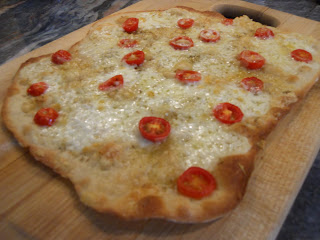Hey there, everyone...sorry for the long absence. It's been a busy couple of weeks but I have some new adventures to share. Last night, my parents had their big 4th of July celebration, which meant plenty of good food and wine to go around. My dad requested that I make Roman pizza. The story behind pizza at our house is this: last summer, when we got a new grill, we also got a pizza stone to experiment with. The goal was to recreate the delicious paper-thin crust pizzas we'd eaten in Rome the summer before. With lots of experimentation and a few mishaps, we're finally starting to get it down.
We made two pizzas last night, one classic margherita and one 3-cheese. It was a big hit, and there was a bit of leftover dough so I made a smaller one today for lunch, using the oven instead of the grill, and changing up the ingredients just a little bit. I used fresh minced garlic, herb olive oil, cherry tomatoes, parmesan, fontina, and taleggio cheeses.
All good pizza starts with the dough. Our Roman pizza dough comes from Peter Reinhart, and is fairly simple to make. We originally found the recipe courtesy of this blog: http://flamingobear.com/2009/05/roman-pizza-dough/. You can fudge a little bit with pizza because it isn't as finicky as other breads. Definitely a good dough to start with if you are new to baking.
The tricky parts of making Roman pizza are 1) getting the dough super-thin, and 2) transferring the raw pizza onto the pizza stone. Also important to note is that you can use your pizza stone either in the oven or on the grill. We prefer the grill because it gets a sort of char on the crust that mimics that of an authentic brick oven. But I use the oven just as often, and either way is delicious.
So, to the process:
Once you've followed the dough recipe above, take the dough out 2 hours prior to baking to let it come to room temperature. Flour a clean counter and transfer the dough gently onto it. Then, using a sharp knife or pizza cutter, divide the dough into 3 or 4 pieces, depending on how big you want your pizzas to be. Keep in mind that the thinner you want your pizza to be, the less dough you need. For a thin crust, one fourth of the dough should do the trick.
Next, shape the dough ball into a round and begin to stretch it into a big circle. You can do this however you like, I use my hands and rolling pin towards the end to get it really thin. I never learned how to toss pizza, but my way works just fine. Also, the thing with homemade pizza is that it doesn't need to be perfectly round.
Once the dough is thin enough, it is time to transfer it to the pizza peel (aka the gigantic pizza spatula thingie). Make sure to first dust the peel with a generous amount of either semolina or cornflour--and I mean generous. This is what helps the pizza slide smoothly onto the stone. I've learned the hard way that you can never have too much semolina on the peel.
Once your peel is dusted and ready to go, gently transfer your dough to the peel and begin adding your toppings.
Baking pizza requires your pizza stone to be very hot. In the oven, 500 degrees usually does the trick. On the grill, 500 to 550 works, but the hotter the better. But since the heat is so high, these suckers cook fast. Once they go in, best not to get distracted.
So once your pizza is dressed and ready for baking, open the oven or grill and gently transfer the pizza onto the stone. This takes a little practice. Place the tip of the peel towards the back of the stone, and give the pizza a little head start with either your fingers (careful, it's hot!) or a spatula, and maybe a little shake, then gently slide the peel out from under the pizza. Easier said than done! But the great thing about pizza like this is that, even if it doesn't turn out pretty, it's always delicious.
Like I said before, these pizzas cook fast, about 5 to 7 minutes depending. It's best to keep an eye on them. Once all the cheese is melted and bubbling, and the edges of the crust are golden brown, it's time to take it out. The good news is, taking the pizza off the stone is a lot easier than putting it on. Just get your peel under the edge and shake the pizza towards you. Then I usually slide the pizza onto a wooden cutting board to slice and serve.
Bellissimo!
Be sure to eat this pizza while it's hot! The thin crust means it cools down quickly, and it doesn't microwave well. Eat it up while it's hot and crispy!
So that's it on the pizza. Stay tuned for chapter two of my bread-making adventures: I'm attempting French country bread this weekend. That's all for now!











I'm inspired! Looks wonderful and I'm sure the taste was delicioso!!! Nealy
ReplyDelete